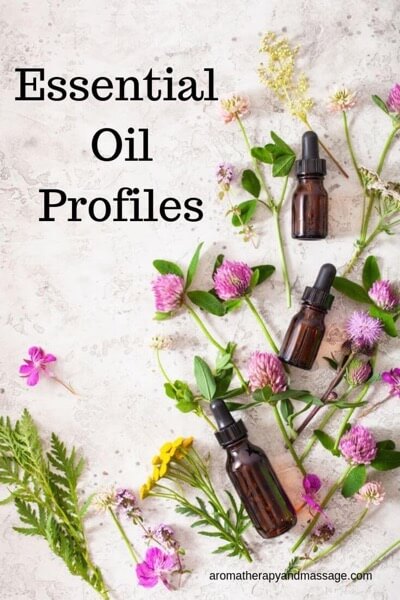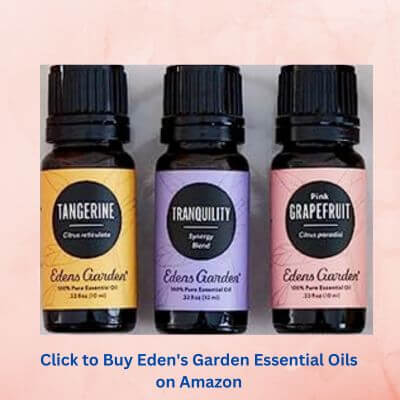- Home
- Essential Oil Profiles
As an Amazon Associate and affiliate with other programs, I may earn revenue from qualifying purchases through affiliate links. This does not affect the price you pay. Privacy Policy / Disclosures. This site is for educational purposes only.
Essential Oils Guide With Essential Oil Profiles
Welcome to my essential oils guide with profiles of more than 120 essential oils. If you want to skip the preliminary information, click here for the list of essential oil profiles.

What Are Essential Oils?
Essential oils are highly concentrated liquids extracted from plants. For the plants, the oils serve purposes such as helping the plant thrive and protecting it from the environment.
The word "essential" doesn't mean necessary or required for humans. "Essential" comes from the poetic way of thinking about the "essence" or "life force" of a plant.
Don't confuse essential oils with infused or macerated oils. These oils are vegetable oils with the fragrance of a plant infused by soaking the plant material in the oil. Infused oils can make good aromatherapy carrier oils.
Making Essential Oils
The most common way to produce essential oils is by steam distilling plant material. A steam distiller has a chamber that holds raw plant material. When steam flows into the chamber, small sacs on the plant open and release the plant oils. The steam and oil move from the chamber into a chilled condenser, which turns the steam into water. The essential oil and water are separated. The water, called an aromatherapy hydrosol, contains some of the plant essence and also has uses in aromatherapy.
Another process less often used to make essential oils used in aromatherapy is hydrodistillation — the plant material is boiled in water, the resulting steam is cooled, and then the water and essential oil are separated.
The other process for making essential oils is expression (also called cold pressing, though that's a technically inaccurate term — it should be cold expressing). It is used primarily to produce citrus oils, where oil is squeezed from the peel.
Solvent Extraction – Absolutes
Some oils, such as jasmine and benzoin, used in aromatherapy aren't technically essential oils but are absolutes. These oils are extracted from plant material using a solvent in a process that produces what is called a concrete. The concrete is then further processed to make an absolute oil.
Another way to make absolutes is enfleurage, which involves placing plant material into solid, odorless fats at room temperature to capture the fragrant compounds. The fat is separated from the plant oils using alcohol. Enfleurage is rare today but was the standard method of producing oils in ancient times.
Carbon Dioxide Extraction
Carbon dioxide (CO2) extraction is a newer process that involves using liquid CO2 as a solvent to extract oils from plants. These products differ in chemistry from distilled essential oils.
Citrus Essential Oils
Introduction to oils made from citrus fruits.
Essential Oils Guide
Here's the list of aromatherapy oils profiled on this website:
- Agarwood Essential Oil
- Allspice Essential Oil (pimento berry)
- Amyris Essential Oil
- Angelica Essential Oil
- Anise Essential Oil
- Balsam Fir Essential Oil
- Basil Essential Oil
- Bay Laurel Essential Oil
- Bay Essential Oil (West Indian)
- Bergamot Essential Oil
- Bergamot Mint Essential Oil
- Benzoin Oil
- Betel Leaf Essential Oil
- Birch Essential Oil
- Black Pepper Essential Oil
- Black Spruce Essential Oil
- Blue Spruce Essential Oil
- Blue Tansy Essential Oil
- Cajeput Essential Oil
- Calamus Essential Oil
- Calendula Oil
- Camphor Essential Oil
- Cannabis Essential Oil
- Caraway Essential Oil
- Cardamom Essential Oil
- Carrot Seed Essential Oil
- Cassia Essential Oil
- Catnip Essential Oil
- Cedarwood Essential Oil
- Celery Seed Essential Oil
- Chamomile: German Chamomile Essential Oil and Roman Chamomile Essential Oil and Moroccan Chamomile Essential Oil and Cape Chamomile Essential Oil
- Cinnamon Essential Oil
- Cistus Essential Oil
- Citronella Essential Oil
- Clary Sage Essential Oil
- Clove Essential Oil
- Coffee Essential Oil
- Copaiba Essential Oil
- Coriander Essential Oil
- Cornmint Essential Oil
- Cumin Essential Oil
- Cypress Essential Oil
- Davana Essential Oil
- Dill Essential Oil
- Elemi Essential Oil
- Eucalyptus Essential Oil
- Fennel Essential Oil
- Fir Essential Oils
- Fragonia Essential Oil
- Frankincense Essential Oil
- Galbanum Essential Oil
- Galangal Essential Oil
- Geranium Essential Oil
- Ginger Essential Oil
- Goldenrod Essential Oil
- Grapefruit Essential Oil
- Helichrysum Essential Oil
- Hinoki Essential Oil
- Ho Wood Essential Oil
- Holy Basil Essential Oil (Tulsi)
- Hyssop Essential Oil
- Jasmine Oil
- Juniper Essential Oil
- Kaffir Lime Essential Oil (Combava)
- Kanuka Essential Oil
- Kunzea Essential Oil
- Lavandin Essential Oil
- Lavender Essential Oil
- Ledum Essential Oil
- Lemon Essential Oil
- Lemon Myrtle Essential Oil
- Lemon Tea Tree Essential Oil
- Lemon Verbena Essential Oil
- Lemongrass Essential Oil
- Lime Essential Oil
- Lotus Oil (Pink, White, and Blue Absolutes)
- Magnolia Essential Oil
- Mandarin Essential Oil
- Manuka Essential Oil
- Marjoram Essential Oil
- Massoia Bark Essential Oil
- May Chang Essential Oil
- Melissa Essential Oil
- Mimosa Absolute
- Muhuhu Essential Oil
- Myrrh Essential Oil
- Myrtle Essential Oil
- Nagarmotha Essential Oil
- Neroli Essential Oil
- Niaouli Essential Oil
- Nutmeg Essential Oil
- Oakmoss Absolute
- Ocotea Essential Oil
- Opopanax Essential Oil
- Orange: Sweet Orange Essential Oil and Bitter Orange Essential Oil
- Oregano Essential Oil
- Palmarosa Essential Oil
- Palo Santo Essential Oil
- Parsley Essential Oil
- Patchouli Essential Oil
- Peppermint Essential Oil
- Peru Balsam Essential Oil
- Petitgrain Essential Oil
- Pine Essential Oil
- Plai Essential Oil
- Ravensara Essential Oil
- Ravintsara Essential Oil
- Rosalina Essential Oil
- Rose Essential Oil
- Rosemary Essential Oil
- Rosewood Essential Oil
- Sage Essential Oil
- Sandalwood Essential Oil
- Saro Essential Oil
- Savory Essential Oil
- Spearmint Essential Oil
- Spike Lavender Essential Oil
- Spikenard Essential Oil
- Tangerine Essential Oil
- Tagetes Essential Oil
- Tarragon Essential Oil
- Tea Tree Essential Oil
- Thyme Essential Oil
- Tonka Bean Absolute
- Turmeric Essential Oil
- Valerian Essential Oil
- Vanilla Absolute
- Vetiver Essential Oil
- Wintergreen Essential Oil
- Yarrow Essential Oil
- Ylang Ylang Essential Oil
- Yuzu Essential Oil
Image Credit: lizashush / 123RF Stock Photo



